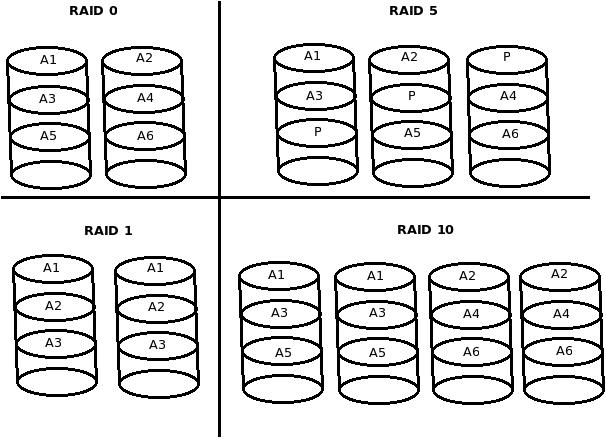RAID Basics & RAID Recovery
RAID Basics:
RAID Systems (In Computers, Servers, NAS, etc) use multiple disk-drives to store data to prevent data loss when individual drives fail & to increase the read/write memory performance. Software based RAID systems provided by the operating systems use the system CPU to create and manage RAID drives while Hardware based RAID systems require a dedicated hardware RAID controller/ processor, that can access multiple disks simultaneously for the same purpose. There are many types of RAID systems and the common ones are RAID 0, 1, 5, 10, etc.
In RAID 0, data is split and written on two disks – Half of it on one disk, and the other half on the other. This type of RAID system is mainly used to improve the read/write operations & memory performance in general as it employs Data striping with multiple disks. It offers no protection for data, as such.
In RAID 1, data is written on one disk and simultaneously copied to another disk (Disk Mirroring). Even if one disk fails, there would be no disruption of services as the system can use the other disk which contains the exact copy of the failed disk. But in RAID 1, the usable disk space is 50% of the total installed capacity.
RAID 10 is a combination of RAID 1 & RAID 0. It needs a minimum of four disks to configure. In this, two disks are paired as one set and data is mirrored within each set, which accounts for data recovery. Data is still split into two and written alternatively on each set of drives – one by one which accounts for data striping and better performance. Usable disk space is 50% of the total installed capacity.
RAID 5 requires minimum 3 disks to implement and it uses parity. If a disk fails, using the parity value (which is a function of data on other two disks) the data which was stored on the failed disk can be calculated for each block. RAID 5 gives good performance as it can use data striping to write across multiple disks & it can also give a better storage efficiency – Usable capacity: Total Capacity Minus Disk capacity of one disk.
Though RAID systems provide for disk redundancy (when one of the disks fail), there are situations where data might still be lost/ inaccessible. Can data from such RAID systems be recovered?
Some reasons for data loss in RAID systems:
-
More than one drive failing at the same time / another drive failing just before the faulty drive is replaced.
-
RAID Controller Card failure/ RAID configuration gets corrupted.
-
Accidental formatting of all Disks/ Bad Sectors.
-
Accidental file deletion (manual errors).
-
Recovery failure after a failed drive is replaced, etc.
Data Recovery for RAID Systems:
There are multiple methods used in recovering data from failed RAID systems, and some of them are discussed below.
A method called ‘striping’ is used in most of the RAID systems which stores the data to various drives in small blocks of 128/256 Kbps (for example). This is referred to as stripe size. So, the files that are smaller than the stripe size (like small text documents, spreadsheets, etc) can be recovered in full as they can be accommodated into a single block and hence may not be split.
But even larger documents that are split into multiple blocks and stored in multiple drives can be recovered by a process called ‘De-Striping’, where each block of data is copied sector by sector from all the drives involved into a new destination and attempts are made to arrange all the sectors in the right order to reconstruct the (larger) original file. It may not be possible to recover all the files like this but depending on the extent of damage, most of them might be recovered.
If the drives in a RAID array are accidentally formatted, it might still be possible to recover data from them depending on how they were formatted – If an OS/ Software was used to format the drives (in high level), the old data might still be available in the free space and can be recovered. But if a Controller was used to format the drives (in low level), there is a chance that data might have been totally erased.
There maybe cases where some hardware components of RAID systems might have been physically damaged – In such cases, the failed components may be replaced to recover the data.
It might be a good idea to take professional help from companies specialized in RAID recovery in case of RAID system data loss/ failure.
excITingIP.com
You could stay up to date on the various computer networking/ related IT technologies by subscribing to this blog with your email address in the sidebar box that says, ‘Get email updates when new articles are published’

Easy to understand between Raids. Advantages of each Raids
Well done
it is easy to learn and understand…